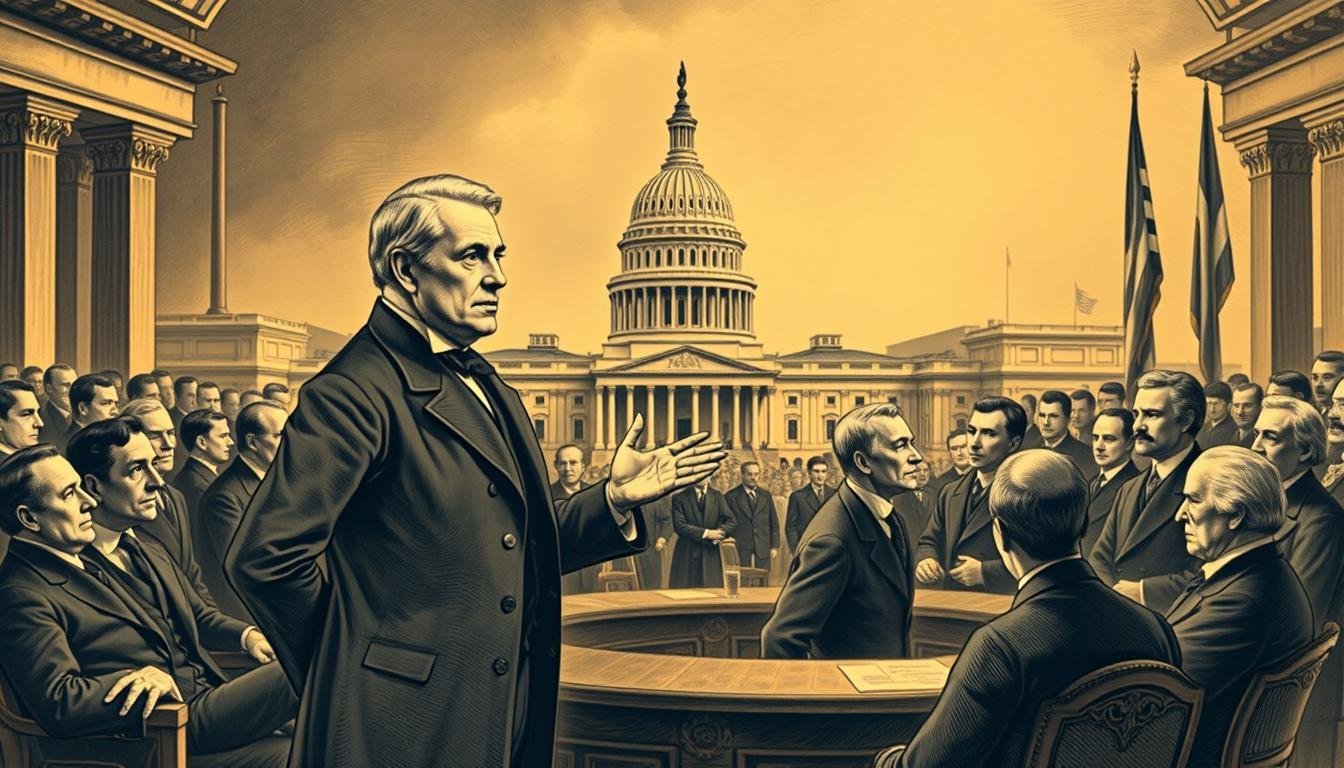Get ready to dive into a crucial time in American history – President Johnson’s Reconstruction plan. This plan was set up after the Civil War. It aimed to rebuild the nation and change how the federal government and states work together.
As you learn more about this, you’ll understand the historical background and the plan’s main parts. The Reconstruction era was a key time in American history. It shaped the country’s future.
You’ll see how Andrew Johnson’s way of handling Reconstruction changed post-Civil War America. This had a big impact on the nation’s direction.
Contents
- 1 The Historical Context of Reconstruction
- 2 What Was President Johnson’s Plan for Reconstruction?
- 3 Implementation and Impact on Different Groups
- 4 Congressional Opposition and the Radical Republicans
- 5 Conclusion: Legacy and Historical Assessment
- 6 FAQ
- 6.1 What was the main goal of President Johnson’s Reconstruction plan?
- 6.2 What was the Loyalty Oath, and how did it work?
- 6.3 How did the Constitutional Conventions shape the new state governments?
- 6.4 How did President Johnson’s Reconstruction plan affect freed slaves?
- 6.5 What was the role of the Radical Republicans in shaping the Reconstruction era?
- 6.6 What were the Reconstruction Acts, and how did they impact the Reconstruction era?
- 6.7 How did President Johnson’s Reconstruction plan affect the relationship between the federal government and the states?
The Historical Context of Reconstruction
To understand President Johnson’s Reconstruction plan, you need to know the historical context. The Reconstruction era lasted from 1865 to 1877. It was a time of great change after the Civil War and the end of slavery.
His Background and Political Views
Andrew Johnson’s background and views shaped his Reconstruction approach. He was the 17th President, trying to unite the nation. Born poor, Johnson educated himself and became a strong Union supporter.
Johnson’s politics were influenced by his life and times. As a Democrat from Tennessee, he started supporting the South but stayed loyal to the Union. This shaped his Reconstruction policies, aiming to let Southern states back into the Union easily.
The Reconstruction era was filled with big changes. New laws, like the 13th Amendment, ended slavery. The 14th Amendment defined citizenship and ensured equal rights.
| Amendment | Purpose | Impact |
|---|---|---|
| 13th Amendment | Abolished slavery | Freed millions of enslaved African Americans |
| 14th Amendment | Defined citizenship and ensured equal protection | Granted citizenship to former slaves and prohibited states from denying anyone equal protection under the law |
Knowing the historical context and Johnson’s background is key to understanding his plan. His soft stance on the South and vetoes of key laws caused tension with Radical Republicans in Congress.
What Was President Johnson’s Plan for Reconstruction?
President Johnson’s Reconstruction plan aimed to rebuild the United States. It included the Loyalty Oath and Constitutional Conventions. These elements worked together to unite America.
The Loyalty Oath
The Loyalty Oath was a key part of Johnson’s plan. It made people swear allegiance to the United States. This oath showed they were committed to the Union and its laws.
However, the Loyalty Oath was controversial. Many former Confederates felt it was a way to humiliate them. Still, it was a core part of Johnson’s plan, testing loyalty to the United States.

Constitutional Conventions were also important in Johnson’s plan. They brought together delegates from the South. These conventions helped draft new state constitutions that followed US principles.
At these conventions, delegates discussed and voted on important issues. They talked about ending slavery and the rights of freed slaves. The new constitutions were a big step towards rebuilding the South and following federal laws.
Looking into President Johnson’s Reconstruction plan helps us understand the complex rebuilding of a nation. The focus on the Loyalty Oath and Constitutional Conventions shows Johnson’s goal for a unified United States.
Implementation and Impact on Different Groups
Let’s look at how President Johnson’s Reconstruction plan was carried out and its effects on different groups. The plan set up Constitutional Conventions. These conventions were key in creating new state governments and laws.
The Constitutional Conventions were mainly attended by former Confederates. Freed slaves and their supporters worried that their interests wouldn’t be represented. This led to decisions that favored white Southerners, who wanted to keep their old ways.
The plan’s impact was different for everyone. Freed slaves found it hard to start anew, often stuck in sharecropping that felt like slavery. White Southerners kept their social status but struggled financially.
Northerners, who wanted slavery abolished, were disappointed. They felt the plan was too soft on former Confederates and changed too slowly.
Social and Economic Changes
The Reconstruction plan brought big changes to the South. New state governments were formed, leading to laws that changed people’s lives.
| Group | Impact of Reconstruction Plan | Economic Changes |
|---|---|---|
| Freed Slaves | Faced challenges in establishing new lives, forced into sharecropping | Limited economic opportunities, poverty |
| White Southerners | Maintained social status, faced economic hardship | Loss of slave labor, economic rebuilding |
| Northerners | Frustrated by leniency towards former Confederates | Economic investment in the South, mixed results |
In conclusion, President Johnson’s Reconstruction plan had big effects on many groups in America. The Constitutional Conventions were a big part of this, shaping laws and governments that affected freed slaves, white Southerners, and Northerners.
Congressional Opposition and the Radical Republicans
President Johnson’s Reconstruction plan faced strong opposition from Congress, especially from the Radical Republicans. They disagreed with Johnson’s lenient approach and wanted to rebuild the South their way.
Leaders like Thaddeus Stevens and Charles Sumner led the Radical Republicans. They thought Johnson was too soft on former Confederates. They pushed for a stricter policy to protect the rights of freed slaves and limit former Confederates’ power.
The Reconstruction Acts
The Reconstruction Acts were laws passed by Congress to counter Johnson’s plan. They split the South into five military districts, each run by a Union general. Southern states had to create new governments with freed men’s participation.
These acts changed the power balance between the executive and legislative branches. Congress showed its strength by overriding Johnson’s vetoes.
The Reconstruction Acts had big effects. They helped African American men vote for the first time. But, they also made Johnson and Congress very tense. This tension led to Johnson’s impeachment by the House in 1868.
| Year | Reconstruction Act | Impact |
|---|---|---|
| 1867 | First Reconstruction Act | Divided the South into five military districts |
| 1867 | Second Reconstruction Act | Outlined the process for Southern states to be readmitted to the Union |
| 1868 | Third Reconstruction Act | Further clarified the role of military commanders in the South |
The Radical Republicans changed Reconstruction’s direction. Their efforts for a fairer South had lasting effects. But, the time was also filled with big challenges and violence.
Conclusion: Legacy and Historical Assessment
You’ve learned about President Johnson’s Reconstruction plan and its big effects. Think about how it changed America after the Civil War. It also started a long fight for civil rights and justice.
The Radical Republicans were key in the Reconstruction era. They fought against President Johnson’s plan. This fight changed how America was rebuilt, shaping its history.
Looking back, President Johnson’s plan helped start civil rights movements. But, it also showed the hard work needed to rebuild a nation. Understanding this history shows how important President Johnson’s plan is to American society today.
FAQ
What was the main goal of President Johnson’s Reconstruction plan?
President Johnson’s main goal was to rebuild the nation. He wanted to redefine how the federal government and states work together after the Civil War.
What was the Loyalty Oath, and how did it work?
The Loyalty Oath was a promise to the United States. People had to swear it to join the Reconstruction. It was a key part of President Johnson’s plan.
How did the Constitutional Conventions shape the new state governments?
Constitutional Conventions were key in creating new state governments. They wrote new state constitutions and laws. This was a big part of President Johnson’s plan.
How did President Johnson’s Reconstruction plan affect freed slaves?
Freed slaves were greatly impacted by President Johnson’s plan. It shaped the laws and governments they lived under. But, the plan was criticized for not protecting their rights enough.
What was the role of the Radical Republicans in shaping the Reconstruction era?
Radical Republicans were important in the Reconstruction era. They opposed President Johnson’s plan and pushed for their own vision. They passed laws like the Reconstruction Acts, changing the balance of power.
What were the Reconstruction Acts, and how did they impact the Reconstruction era?
The Reconstruction Acts were laws passed by Congress. They aimed to protect freed slaves and change Southern state governments. These acts were a big shift in power between the executive and legislative branches.
How did President Johnson’s Reconstruction plan affect the relationship between the federal government and the states?
President Johnson’s plan aimed to change the federal-state relationship. But, it was criticized for not protecting all citizens, especially freed slaves. Its impact was complex and shaped American history.

Hi, I am Tatum Bradford from Washington. I have a background in political science and work as a senior revenue officer. I love learning about U.S. presidents and sharing interesting facts about political history.

